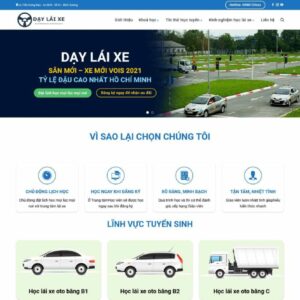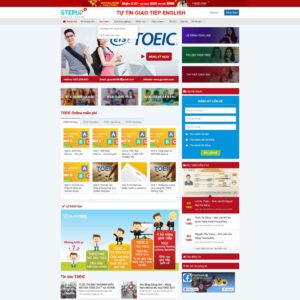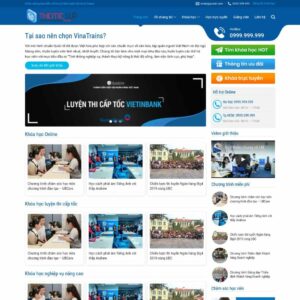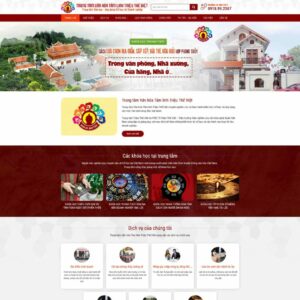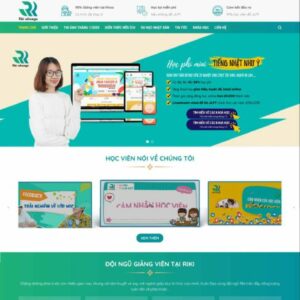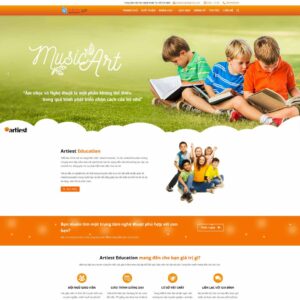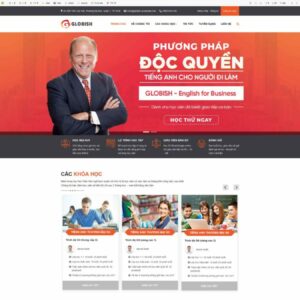
The WordPress Training 2 theme helps you create an attractive training website, attracting students with categories like: Course Sales, Marketing, Services, and Business.
Driving School WordPress Theme 2 features a user-friendly interface, making it easy for students to look up instructors, class schedules, and course prices.
Explore the professional WordPress theme for teaching musical instruments, ideal for categories like Sales, Business, Study Abroad, and Hot Themes. Optimized for enhancing the learning experience.
Design a perfect business and study abroad website with the WordPress theme Edu 4, optimized for easy SEO and effectively attracting customers.
WordPress Theme Edu 5 is specially designed for businesses and study abroad, offering flexibility and a modern style for your educational website.
Looking for a professional WordPress theme for exam preparation in the fields of Services, Business, and Study Abroad. SEO optimized, easy to customize, and user-friendly.
Discover a professional WordPress theme for teaching Feng Shui, suitable for services, businesses, and study abroad. Elevate your website today.
Explore the WordPress theme for learning Japanese, suitable for businesses and study abroad. It helps you create a professional website that attracts learners.
Theme WordPress Edu 8 for businesses and study abroad, designed to optimize content and effectively attract customers. Suitable for all areas of education.
The WordPress school theme 01 is designed specifically for study abroad, featuring an elegant and user-friendly layout that helps you create a professional and engaging educational website.
The WordPress education theme Edu 9 features a modern, user-friendly, and minimalist design, providing a professional feel that allows users to easily navigate and experience the site.
Explore the perfect WordPress theme for beauty courses with categories: Course Sales, Business, Study Abroad, Landing Page, Cosmetics, and Spa Aesthetics.
1. Benefits of Designing a Professional Study Abroad Website
Having a professional study abroad website is an effective way for businesses to reach potential students and provide comprehensive and timely information about studying abroad. An SEO-optimized website increases visibility on search engines, attracts potential customers, boosts conversion rates, and builds a reputable brand in the study abroad field. Additionally, the website serves as a platform where students and parents can easily learn about study programs, scholarships, visa procedures, and life abroad.
2. Essential Features for a Study Abroad Website
A study abroad website needs to integrate essential features to provide the best user experience. The interface should be user-friendly, easy to navigate, and optimized for information searching and consultation registrations by students.
2.1. User-Friendly Interface for Optimal Experience
The study abroad website should have a simple yet professional design, utilizing harmonious colors, sharp images, and a logical layout. Content should be clearly organized to help students easily find the information they need. Call-to-action (CTA) buttons like “Register for Consultation” and “View Study Programs” should be prominently placed to encourage customer interaction, making the experience convenient.
2.2. Detailed Information System for Study Programs
The website should have a comprehensive information directory about various study programs, including: studying in the USA, UK, Australia, Japan, etc. Each program should have a detailed information page that includes: school introduction, subjects offered, admission requirements, costs, scholarships, and necessary procedures. Information should be regularly updated to meet the needs of students.
2.3. Integrated Online Consultation Registration Feature
The online consultation registration feature is essential for a study abroad website. Students can easily register for consultations by filling out personal information, selecting a suitable date and time, and submitting their requests. Integrating this feature helps businesses efficiently manage registration information, thereby increasing conversion rates and enhancing professionalism in consulting services.
3. SEO-Friendly Design Process for Study Abroad Websites
Designing an SEO-friendly study abroad website is crucial for effectively reaching students. A standardized design process will create a good user experience and help the website rank highly on search engines.
3.1. Conceptualizing the Interface Design
The website interface should be modern and creative, focusing on displaying detailed information about study programs in an accessible manner. CTA buttons like “Register for Consultation” and “Learn More” should be easily visible to encourage student interaction. Images of universities, students, and study abroad experiences should be used to create appeal and trust.
3.2. Creating Quality Content
The content on the website should focus on providing detailed information about study programs, sharing study abroad experiences, and guiding visa application processes and scholarship searches. Relevant keywords such as “study abroad website design” and “study program” should be used naturally within the content to optimize SEO. Regularly updating content and sharing useful information helps attract and retain students while enhancing the business’s credibility.
3.3. On-Page SEO Optimization
Optimize SEO elements such as title tags, meta descriptions, headings, URLs, and ALT tags for images. Use internal linking between study program pages and articles on the website to increase connectivity and assist students in their information searches. Optimizing page load speed and user experience is also crucial for improving search engine rankings.
4. Modern Trends in Study Abroad Website Design
Current trends in study abroad website design focus on user experience, integrating modern features, and optimizing interfaces.
4.1. Minimalist Interface Design Focused on Information
The design should be minimalist yet modern, emphasizing clear display of information about study programs, scholarships, and visa application guidelines. CTA buttons like “Register for Consultation” and “Learn More” should be placed prominently to encourage student action. Utilizing images and illustrative videos will make content more engaging and visually appealing.
4.2. Integration of Experience-Sharing Videos
Integrating videos that share experiences from former students enhances the website’s appeal, providing practical and authentic information about studying abroad. Videos not only increase interactivity but also improve time spent on the page, which can enhance SEO rankings.
4.3. Mobile Optimization
The study abroad website must be compatible with all devices such as computers, phones, and tablets, allowing students to access information anytime, anywhere. This enhances user experience and increases the likelihood of reaching potential customers, especially among students who frequently use mobile devices.
5. Choosing a Reputable Study Abroad Website Design Agency
To have a professional study abroad website, businesses need to choose a reputable agency with experience in educational and study abroad website design. This agency should provide comprehensive design, programming, and SEO optimization services, ensuring the website operates effectively, attracts students, and enhances user experience.
Conclusion
Designing an SEO-friendly study abroad website is the optimal solution for businesses to reach potential students, effectively promote study programs, and enhance brand credibility. Invest in website design today to build a professional image and achieve sustainable growth in the study abroad consulting sector.
Related Keywords:
- Study abroad website design
- Study programs
- Online study abroad consultation
- Professional study abroad website

